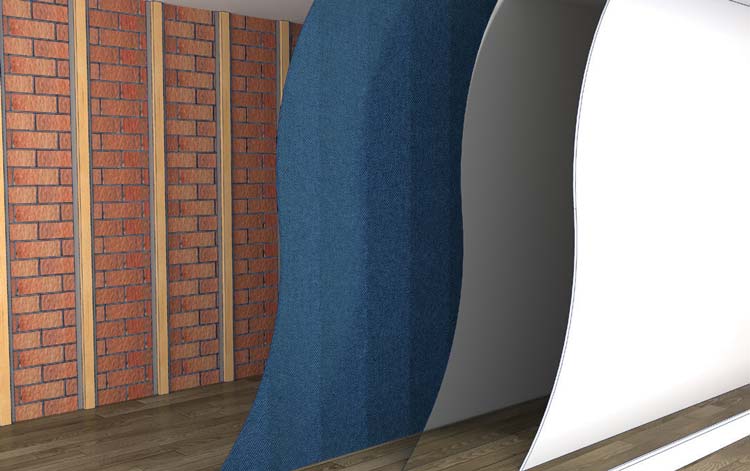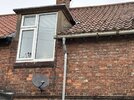- Joined
- 28 Oct 2023
- Messages
- 5
- Reaction score
- 0
- Country

Hi everyone – I'm looking for some advice on our 1910 solid brick wall terraced house in the UK which we are planning to renovate. Unusually, it has some prefabricated 105mm thick concrete dormers and I'm not sure how best to renovate them. We are in a conservation zone, so have no choice but to insulate them internally. Currently, both the cheeks and the ceiling of the dormers collect a lot of condensation, and we have to wipe them down daily in winter to avoid mould growth.
Option A – Leave As They Are
My logic is that once the rest of the property is insulated, both the house and the concrete dormers will be warmer. According to U-value analysis, as long as the surface temperature of the concrete is above 15 degrees Celsius, condensation shouldn't form. Whether this is achievable in reality, I'm not sure. The concrete could end up being a giant cold bridge which only exacerbates the problem. We would also lose a significant amount of heat through the concrete which I'm keen to avoid.
Option B – Insulated Plasterboard
My second option is to glue a 22mm layer of insulated plasterboard (Gyproc ThermaLine) to the concrete. This would increase the internal surface temperature and thus prevent any condensation. However, the insulation would result in the concrete's temperature falling below freezing during winter as it is no longer warmed by the internal air. If water from driving rain is held within the concrete, the concrete could be at risk of frost damage. Does anyone have any experience with this, and how likely and severe frost damage would be? To prevent driving rain from entering the concrete, I could seal it externally. However, as the insulated plasterboard isn't breathable, this would trap any existing moisture inside the concrete. I was told that, as long as the relative humidity of the concrete is below 75% before sealing, this shouldn't be a problem. However, I haven't been able to verify this. Does anyone have information on the moisture levels of concrete before sealing in an external environment?
Option C – Insulate with Spacetherm
Similar to above, I could opt for Spacetherm as this offers the thinnest insulation solution. However, Spacetherm is a breathable solution. This means, that to stop condensation from forming on the surface of the concrete behind the insulation, I would also need to add a vapour control layer. This means I would also have all the problems that come with the insulated plasterboard, plus the risk of gaps in the VCL leading to condensation behind the insulation on the concrete surface.
If anyone has any experience in relation to this, and could recommend a solution, it would be much appreciated. For reference, we plan to install either extraction fans or whole-house MEV to reduce the amount of moisture in the air. Currently, we just have to open a window.
Option A – Leave As They Are
My logic is that once the rest of the property is insulated, both the house and the concrete dormers will be warmer. According to U-value analysis, as long as the surface temperature of the concrete is above 15 degrees Celsius, condensation shouldn't form. Whether this is achievable in reality, I'm not sure. The concrete could end up being a giant cold bridge which only exacerbates the problem. We would also lose a significant amount of heat through the concrete which I'm keen to avoid.
Option B – Insulated Plasterboard
My second option is to glue a 22mm layer of insulated plasterboard (Gyproc ThermaLine) to the concrete. This would increase the internal surface temperature and thus prevent any condensation. However, the insulation would result in the concrete's temperature falling below freezing during winter as it is no longer warmed by the internal air. If water from driving rain is held within the concrete, the concrete could be at risk of frost damage. Does anyone have any experience with this, and how likely and severe frost damage would be? To prevent driving rain from entering the concrete, I could seal it externally. However, as the insulated plasterboard isn't breathable, this would trap any existing moisture inside the concrete. I was told that, as long as the relative humidity of the concrete is below 75% before sealing, this shouldn't be a problem. However, I haven't been able to verify this. Does anyone have information on the moisture levels of concrete before sealing in an external environment?
Option C – Insulate with Spacetherm
Similar to above, I could opt for Spacetherm as this offers the thinnest insulation solution. However, Spacetherm is a breathable solution. This means, that to stop condensation from forming on the surface of the concrete behind the insulation, I would also need to add a vapour control layer. This means I would also have all the problems that come with the insulated plasterboard, plus the risk of gaps in the VCL leading to condensation behind the insulation on the concrete surface.
If anyone has any experience in relation to this, and could recommend a solution, it would be much appreciated. For reference, we plan to install either extraction fans or whole-house MEV to reduce the amount of moisture in the air. Currently, we just have to open a window.


